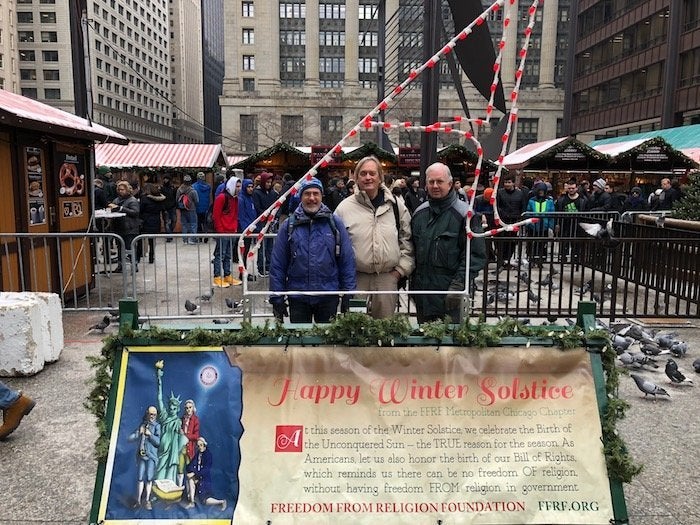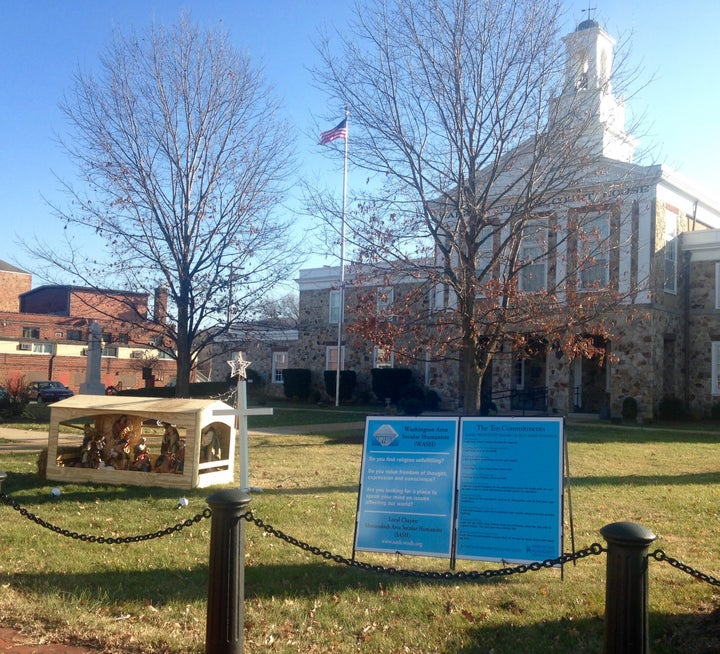
Secular organizations have long flexed their First Amendment rights in December by placing non-religious holiday displays on courthouse lawns and in town squares, parks and capitol rotundas across the U.S.
Some of the displays are solemn and earnest, like a lighthouse-shaped obelisk that illustrates the power of light in a time of darkness. Others are purposefully irreverent ― like the exhibits appearing in several states this year that twist the traditional Christian nativity scene by placing the Bill of Rights in a manger.
All are designed to make a point: If the government allows Christmas trees and Hanukkah menorahs to occupy public property, it also needs to offer space to people who aren’t part of a religious tradition.
The defense of non-religious folk is especially important this holiday season, according to Annie Laurie Gaylor, co-president of the Freedom From Religion Foundation (FFRF), a Wisconsin-based advocacy group that is involved with a number of secular holiday displays this year.
Secular activists are concerned, Gaylor said, about “Christian nationalist” sentiment in U.S. politics and the changes to the makeup of the Supreme Court under President Donald Trump’s watch. She said they’re also worried about the efforts of some conservatives to use the right to religious liberty as a means to discriminate based on religion.
For Gaylor and others, secular displays during the holiday season are ultimately about the separation of church and state.
“It has never been more important to speak up for the constitutional principle of separation between religion and government because that principle has never been more imperiled,” Gaylor said. “So the seasonal violations give us a special chance to do so.”
While national secular organizations like the FFRF play a role in some holiday displays, these exhibits are often organized by area residents or local groups reaching out to their own communities.
Most of the secular advocates surveyed by HuffPost said they’d prefer not to have any religious or secular imagery on public property during the holiday season. The secular displays usually pop up in places where a religious display has already been installed. The FFRF and other organizations have often threatened legal action when local public officials chose to use only Christian imagery during the holiday season.
It’s important that the religious and the non-religious are treated equally, said Rachel Laser, president of Americans United for Separation of Church and State.
“America is an intentionally and vibrantly diverse country,” Laser said. “Not only is inclusivity required by the Constitution, but it is a potent reminder to government leaders of the true religious diversity of the people they represent.”
An increasing number of Americans appear to be embracing the cultural aspects of Christmas while shedding the more religious elements, according to the Pew Research Center. The religiously unaffiliated make up about 23 percent of American adults, including the 3 percent who identify as atheists, 4 percent who identify as agnostic and about 16 percent who say they’re “nothing in particular.” Nearly 70 percent of the unaffiliated group think of Christmas more as a cultural holiday than a religious one, according to a 2017 Pew study.
Gaylor said she thinks of the winter solstice, which falls on Dec. 21 this year, as a “natural holiday.”
“Christians do not own this time of year — most of the festivities stem from pagan customs about the Winter Solstice,” Gaylor said. “So the Christians really ‘stole’ Christmas.”

A growing minority of Americans oppose the idea of religious symbols being displayed on government property, Pew surveys have found. Forty-five percent of the religiously unaffiliated say they don’t think religious symbols should appear on public property ― that’s more than any other religious grouping ― although 50 percent of the unaffiliated remain OK with the idea. Even white evangelical Protestants, the group most likely to accept nativity scenes on public property, have become less accepting of the idea over time: 80 percent said such displays were OK in 2017, down from 90 percent in 2014.
FFRF members or supporters are expected to place at least 17 secular displays on public property across 14 states this year, Gaylor said. Many of those displays feature a nativity scene and a quote from Gaylor that celebrates the winter solstice and criticizes religious belief:
At this season of the Winter Solstice, may reason prevail.
There are no gods, no devils, no angels, no heaven or hell.
There is only our natural world.
Religion is but myth and superstition that hardens hearts and enslaves minds.
The FFRF exhibit inside the Wisconsin Capitol building, which was set up on Dec. 3, has appeared there during the holidays for 23 years running.
A local Illinois chapter of the Satanic Temple, a non-theistic organization, placed a statue in that state’s Capitol rotunda earlier this month, near a nativity scene, a menorah and an FFRF exhibit. The sculpture shows a woman’s forearm encircled by a snake and holding an apple, a pointed reference to the Biblical story of Adam and Eve’s temptation. A sign underneath the “Snaketivity” sculpture reads, “Knowledge is the greatest gift.”
Chalice Blythe, a senior member of the Satanic Temple’s national council, told HuffPost that the display was created to send a message of “plurality and religious liberty.”
“As Satanists, we do not endorse or practice proselytization and this is especially true of our endeavors to participate in the public forum,” Blythe wrote in an email. “However, when one religion is allowed a monopoly over a public space such as a government building or a town park, to the exclusion of other belief systems, it sends a message that some religious beliefs receive official government endorsement, and others do not. It is a subtle, but tangible, example of the erosion of the separation of church and state.”
In Front Royal, Virginia, the Shenandoah Area Secular Humanists have placed a “Ten Commitments” sign next to the Christian nativity scene on the courthouse lawn for more than 10 years. The Ten Commitments are a set of core humanist values.

Martha Heisel, group coordinator for the Shenandoah humanists, said that about eight years ago, a wooden sign they’d used was damaged in what she believes was an intentionally set fire. The group replaced that sign with a metal one.
“We do not have any particular hope for more people to appreciate our effort,” Heisel told HuffPost. “But we just hope that passersby will read the sign and understand that humanists are people who have compassion, reason, and care for others in our hearts. We will continue to try to encourage people to think.”
In addition to making a statement about church-state separation, secular holiday signs serve another crucial purpose ― helping atheists and other non-religious folk find community during a season when the religious beliefs of many other people seem to be constantly on display.

These exhibits help atheists and people questioning their faith realize that they aren’t alone, according to Nick Fish, national president of American Atheists.
“We receive countless emails, calls, and messages every year from people letting us know that they found an atheist community because of our holiday displays,” Fish said.
The community-gathering aspect of winter displays is something that draws humanists as well.
In New Haven, Connecticut, the Yale Humanist Community’s lighthouse-shaped monument has been placed at the town green for the second year in a row. The exhibit was created to stand next to the city’s Christmas tree, a nativity scene and a Hanukkah menorah. Organizers told HuffPost last year that they hoped it would be a source of comfort for secular people who feel excluded during the holiday season.
Sarah Henry, spokesperson for the national American Humanist Association, said she hopes that all these secular holiday displays help people without a religious faith feel welcome in their neighborhoods.
“For secular folks, I hope that seeing a specifically nonreligious holiday display as part of a collection of public displays marking the season of giving reminds them that they are welcome and valued members of their communities and makes the winter months a little bit warmer,” Henry said.

